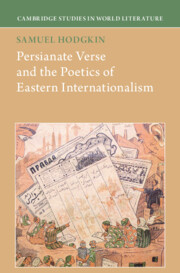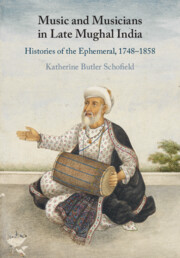55 results
7 - From Memphis to Alexandria
-
-
- Book:
- The Nile Delta
- Published online:
- 15 February 2024
- Print publication:
- 22 February 2024, pp 249-274
-
- Chapter
- Export citation
Crossing boundaries: reading Mirṣād al-‘Ibad in early modern China (redrawing and straddling borders)
-
- Journal:
- International Journal of Asian Studies , First View
- Published online by Cambridge University Press:
- 10 January 2024, pp. 1-13
-
- Article
-
- You have access
- Open access
- HTML
- Export citation
Chapter 4 - Translations
-
- Book:
- Persianate Verse and the Poetics of Eastern Internationalism
- Published online:
- 14 December 2023
- Print publication:
- 21 December 2023, pp 131-164
-
- Chapter
- Export citation
Chapter 2 - Canons
-
- Book:
- Persianate Verse and the Poetics of Eastern Internationalism
- Published online:
- 14 December 2023
- Print publication:
- 21 December 2023, pp 67-104
-
- Chapter
- Export citation
Chapter 5 - Recognitions
-
- Book:
- Persianate Verse and the Poetics of Eastern Internationalism
- Published online:
- 14 December 2023
- Print publication:
- 21 December 2023, pp 165-196
-
- Chapter
- Export citation
Chapter 1 - Tribunes
-
- Book:
- Persianate Verse and the Poetics of Eastern Internationalism
- Published online:
- 14 December 2023
- Print publication:
- 21 December 2023, pp 35-66
-
- Chapter
- Export citation

Persianate Verse and the Poetics of Eastern Internationalism
-
- Published online:
- 14 December 2023
- Print publication:
- 21 December 2023

Music and Musicians in Late Mughal India
- Histories of the Ephemeral, 1748–1858
-
- Published online:
- 09 November 2023
- Print publication:
- 23 November 2023
The Cultural Impact of the Persian Language in and around Bidlis
-
- Journal:
- Iranian Studies / Volume 57 / Issue 1 / January 2024
- Published online by Cambridge University Press:
- 03 November 2023, pp. 27-45
- Print publication:
- January 2024
-
- Article
-
- You have access
- Open access
- HTML
- Export citation
Two Raji Dialects Converge with Persian: Contrasting Responses to Contact Influence
-
- Journal:
- Iranian Studies / Volume 57 / Issue 1 / January 2024
- Published online by Cambridge University Press:
- 18 August 2023, pp. 73-99
- Print publication:
- January 2024
-
- Article
-
- You have access
- Open access
- HTML
- Export citation
3 - Who’s who in the XX Palmyrenorum
-
- Book:
- Latin Military Papyri of Dura-Europos (<i>P.Dura</i> 55–145)
- Published online:
- 21 July 2023
- Print publication:
- 10 August 2023, pp 41-161
-
- Chapter
- Export citation
Matteo Ricci as an Islamicate informant. Two moments of connection in the Persian afterlives of a Latin account of China
-
- Journal:
- Journal of the Royal Asiatic Society / Volume 33 / Issue 4 / October 2023
- Published online by Cambridge University Press:
- 28 July 2023, pp. 971-990
- Print publication:
- October 2023
-
- Article
-
- You have access
- Open access
- HTML
- Export citation
11 - Multilingualism and the End of the Ottoman Empire: Language, Script, and the Quest for the ‘Modern’
-
-
- Book:
- Multilingualism and History
- Published online:
- 20 April 2023
- Print publication:
- 27 April 2023, pp 205-222
-
- Chapter
- Export citation
5 - Ethnogenesis and Heresy
- from Part II - Heresy and Society
-
- Book:
- Heresy and the Formation of Medieval Islamic Orthodoxy
- Published online:
- 06 April 2023
- Print publication:
- 13 April 2023, pp 153-183
-
- Chapter
- Export citation
18 - Male Necklaces in the East and West
- from Part VI - Shared Forms, Distinct Functions
-
-
- Book:
- Etruria and Anatolia
- Published online:
- 02 March 2023
- Print publication:
- 09 March 2023, pp 318-332
-
- Chapter
- Export citation
17 - Anatolian Fashion in Etruscan Clothing
- from Part VI - Shared Forms, Distinct Functions
-
-
- Book:
- Etruria and Anatolia
- Published online:
- 02 March 2023
- Print publication:
- 09 March 2023, pp 303-317
-
- Chapter
- Export citation
Hindu: A History
-
- Journal:
- Comparative Studies in Society and History / Volume 65 / Issue 2 / April 2023
- Published online by Cambridge University Press:
- 20 January 2023, pp. 246-271
-
- Article
-
- You have access
- Open access
- HTML
- Export citation
1 - The Arabic, Persian and Turkish Mirror Literatures
- from Part I - Introduction
-
- Book:
- Medieval Muslim Mirrors for Princes
- Published online:
- 15 January 2023
- Print publication:
- 05 January 2023, pp 3-23
-
- Chapter
- Export citation
Chapter 6 - Winter in the Modernist Garden
- from Part III - Aftermath
-
- Book:
- Reorienting Modernism in Arabic and Persian Poetry
- Published online:
- 24 November 2022
- Print publication:
- 08 December 2022, pp 143-164
-
- Chapter
- Export citation
Chapter 2 - Travel Forms
- from Part I - Crafting a Modernist Geography across Arabic and Persian Poetry
-
- Book:
- Reorienting Modernism in Arabic and Persian Poetry
- Published online:
- 24 November 2022
- Print publication:
- 08 December 2022, pp 48-70
-
- Chapter
- Export citation



